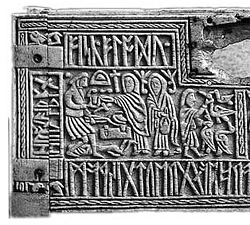3700 B.C.—Sumerians developed the idea of systemic phoneticism and used cuneiform which would be widely borrowed and adapted.
Systemic phoneticism—a tool for specifying isolated particles of information, such as transcribing foreign words or phonetically sounding out hard to identify signs that hold several possible meanings. (History of Writing by Steven Roger Fischer)
3100 B.C.—Egyptian hieroglyphics emerged when the Egyptians borrowed the idea of writing, logography, phonography, and linearity with sequencing from the Sumerians.
2500 B.C.—Mesopotamian cuneiform script was completely capable of conveying any and all thought.

2000 B.C.—Egyptian scribes developed a 26-uniconsonantal-sign alphabet which spread quickly among Egypt’s Semitic vassals, living in Egypt as slaves, mercenaries, and resident aliens.
1500 B.C.—Proto-Sinaitic derived from Egyptian hieroglyphics was used in Caanan to write Caananite, the ancestral script of Phoenician and Hebrew. (BAS Library)
1000 B.C.—The Phoenicians converted the Proto-Sinaitic pictorial Caananite alphabet to a simplified nonpictorial Phoenician consonantal alphabet. All Western alphabets derive from this script.

850 B.C.—The Greeks borrowed the Phoenician’s consonantal alphabet, finding it to be a faster and easier way for accountancy than syllabic writing, and added vowels.
775 B.C.—The Etruscans were settled by the Greeks and borrowed the Greek alphabet to create the Euboean-Etruscan alphabet, which was Italy’s prevalent writing system until 200 B.C. when Etruria was assimilated into the Roman Empire.
650 B.C.—The Romans borrowed the Euboean-Etruscan alphabet to write Latin and spread a modified version, the Latin alphabet, throughout the Roman Empire.
55 B.C.—The first British exposure to the Roman alphabet took place when Julius Caesar first invaded Great Britain.
300 A.D.—The Romans developed uncial writing, a modification of square capital writing and the origin of present day lower-case letters.
600 A.D.—Christian missionaries from Ireland and Europe took the Latin alphabet to England where it replaced the Etruscan-influenced Germanic runic alphabet, Futhorc.
100–1100 A.D.—Reign of Old English alphabet, a.k.a. Anglo-Saxon, and transition away from runic Futhorc alphabet. Beowulf is written in Old English.
1100–1450 A.D.—Reign of Middle English alphabet, the alphabet used to write Canterbury Tales.
1450 A.D.—Modern English alphabet emerges, the alphabet of Shakespeare and the internet.
1927 A.D.—Television is first broadcast.
1950 A.D.—Emergence of Visual Language.
1961 A.D.—MIT develops Compatible Time-Sharing System (CTSS) which allows up to 30 users to log in at the same time and share messages.
1980 A.D.—CompuServe’s CB Simulator simulates citizen’s band radio through text-based messages and user handles.
1982 A.D.—Emoticons were started by Scott Fahlman, a Carnegie Mellon University professor; Commodore 64 PC is released and includes internet service.
1990s—U.S. schools begin to drop cursive writing from their curriculums.
1995 A.D.—Texting was introduced as a way for phone networks to communicate important messages to their subscribers.
1996 A.D.— Mirabulus launched ICQ; text-based messenger that reached broad online audience.
1997 A.D.—AOL launched AIM which allows users to send messages to each other and create profiles, included away messages and icons.
1998—Yahoo Messenger, chat room service.
1999 A.D.—Microsoft releases MSN Messenger, which tells users when friends are online and enables them to exchange messages.
2000 A.D.—Jabber, a multiprotocol instant messenger, allows users to users to chat with friends.
2003 A.D.—Skype users can communicate with each other via video, voice, and instant messaging.
2004 A.D.—Facebook is founded.
2005 A.D.—Google Talk (Google Chat) appears in Gmail user’s window, allowing real-time communication with email contacts as long as they are online with Gmail.
2006 A.D.—MySpaceIM, users and instant message with each other on their desktops.
2008 A.D.—Facebook Chat, users can instant message with one or multiple people.
2011 A.D.—Facebook Messenger, a mobile app, is released; users can message each other from their handheld devices; Apple announces iMessage.
2013 A.D.—Common Core ceases to require U.S. public schools to teach cursive handwriting. At least 41 U.S. states do not teach cursive reading or writing.
A great post about the history of our alphabet is on I Love Topography.







Thank you so much for this- I am doing a project and it was really helpful!
LikeLiked by 2 people
I’m so glad. Thank you for letting me know.
LikeLiked by 1 person
Thank you 🙂 This article will be referenced in one of my next publications 🙂
LikeLiked by 1 person